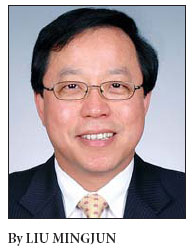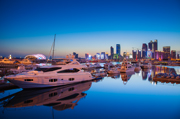Qingdao leads the nation in marine developments
( China Daily )
Updated: 2011-11-03
|
|||||||||
In 2010, Qingdao's marine-related industries had an output value of 168.3 billion yuan ($26.5 billion), an increase of 17.43 percent year-on-year, and 35 billion yuan in marine equipment manufacturing.
Qingdao has become one of the largest ship manufacturers and maritime project developers in Asia, as well as a unique research base for marine biomedicines and chemical products, for China.
Qingdao's port has been ranked 7th in the world, in cargo handling capacity, and 8th, in container handling. The Sino-US, East-Asia, and Asian-Pacific submarine cables all reach Qingdao, which has increased its status as China's communication center.
Its infrastructures, such as the Jiaozhou Bay Bridge, one of the world's longest cross-sea bridge, and the undersea tunnel, have added to its image. A subway is now under construction and it handles a total of 108 domestic and international airlines.
Aiming to be the best
Qingdao is also stepping up efforts in emerging or cutting-edge marine industries and hopes to take the lead in developing a marine economy. It would like to have added value output of 115 billion yuan for its marine industries, by 2015, and 220 billion yuan, by 2020, with annual growth of 14 percent.
The development pattern of the "blue economy" has been described as "one bay, five zones, and multiple support areas" and an economic cluster area for harbor logistics, modern fisheries, seaside tourism, and marine life, has taken shape around Jiaozhou Bay.
Special attention has been given to five areas - the Dongjiakou Port industrial zone; an economic zone on the west side of Jiaozhou Bay; a high-tech zone on its northern side; a modern service zone on its eastern side; and the Aoshan demonstration zone for marine scientific and technological innovations.
A number of support areas will be added, to make full use of the peninsula's advantages and inject some life into the blue economic zone's development.
To make certain that this happens the local government has its focus on developing the more advantageous sectors. First of all, its primary industry, fisheries, will be emphasized to make the city a modern breeding and processing base for aquatic products.




